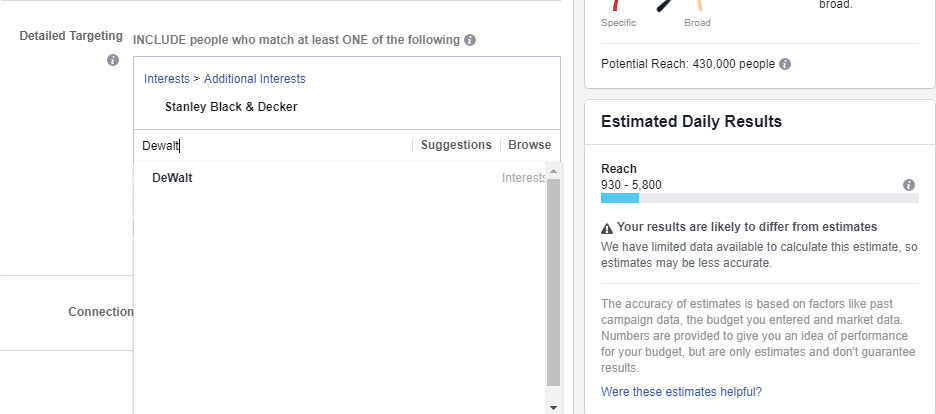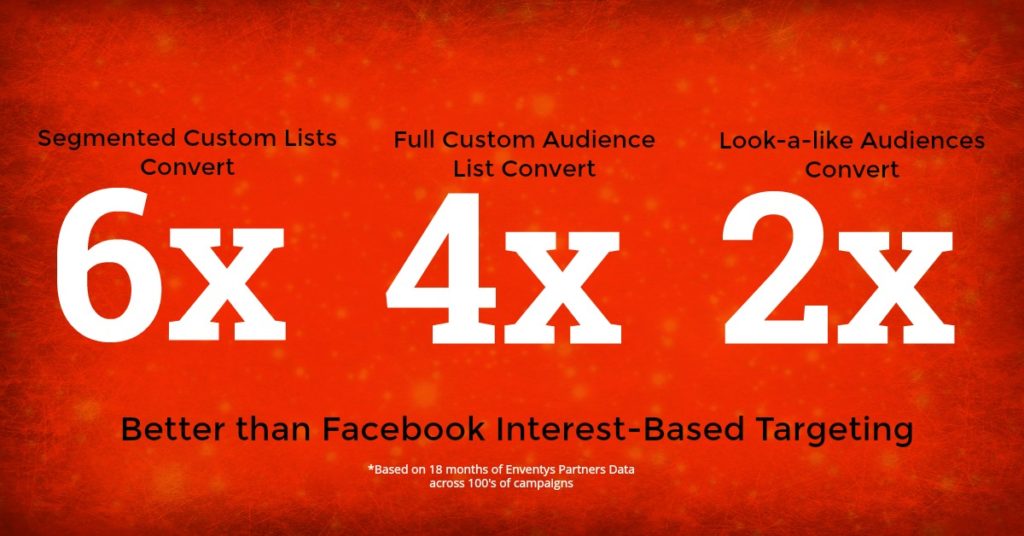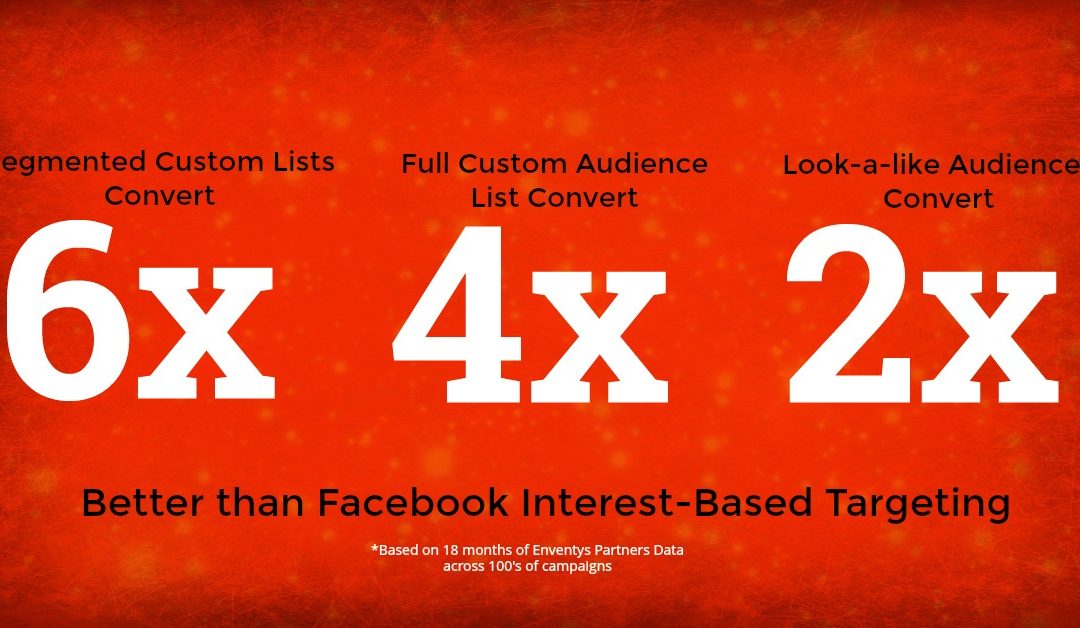Are you looking to get started with Facebook Advertising for your business? Or you have tried Facebook Ads, but your results were far from stellar?
Last year at Enventys Partners, we tracked millions in revenue directly from our Facebook Ad Traffic for product launches on Kickstarter and Indiegogo.
Yes, millions in tracked revenue! (Facebook even featured one of our campaigns as a success story here)
One key to our success is the power of Facebook Custom Audiences.
The last couple of years we have been tracking the data (shared below) and the power of custom audiences is incredible. If you are just starting with Facebook Ads or looking to improve poor results, my recommendation is to start with custom audiences.
What are Facebook Custom Audiences?
Custom Audiences are audiences created with the use of your customer or website data. Once these Custom Audiences are set up in Facebook Business Manager, you will be able to target your past customers, website visitors or email leads with Facebook Ads.
- Email Lists. Facebook gives you the ability to upload email lists in order to target those lists with specific ads. These email lists can be made up of customers, leads, or newsletter subscribers.
- Website Traffic. If you properly install the Facebook Pixel on your website, then you can create custom audiences based on your website traffic. You can create an audience of ALL your website visitors in given period of time OR you can create an audience made of people who only went to specific pages on your site.
Once you have properly set your Facebook Custom Audiences in Facebook Business Manager, then you will be able to create ads that only target these audiences.
If you are not using custom audiences today, imagine the possibilities:
- Would you like to create Facebook Ads that only your past customers see on Facebook? You can create special offers just for your past customers. You could let your past customers know about business updates or new services provided. You could create a referral program for your past customers. There is a lot of potential messages or offers that you’d only want your past customers to get.
- Would you like to retarget people who have recently visited a specific page on your site? Let’s say hammers is a product you sell on your site. Would you like to retarget everyone who has been to the hammer product page with a video ad showcasing your hammers in action? Would you like to retarget the ones who did not buy the hammer a week later with a special 10% discount good for 24 hours?
Hopefully, the wheels are turning on how you can utilize custom audiences for your business. Now, let’s dive into some data.
Custom Audiences vs Interest-Based Targeting
What is interest-based targeting? Over the last 10+ years, Facebook users click on links, like Facebook Pages, and buy items from websites with the Facebook Pixel. Facebook knows what users like, click on, and purchase. Facebook makes this interest-based targeting available to all marketers.
Example: If you are selling hammers, you could target people interested in well-known tool manufacturers:

Interest-based targeting is pretty powerful by itself. If you are selling innovative new hammers, these people will probably be pretty interested in learning more.
Custom Audience vs Interest-Based Targeting Conversion Rates:
We are driving more than $4 million in Facebook traffic per year. The targeting we use is a mix of custom audiences, Look-a-like Audiences (defined below), and Interest-based Targeting.
We have a huge master list of all of our past customers.
We also segment this list of past customer based on the type of product that they have pre-ordered. We have Fashion, High-Tech, Wearables, Outdoor Products, Kitchenware, Kids Products, plus many more segments based on actual purchases.
We target our segmented lists on relevant new product launches. For instance, we will target the wearables past buyer segment when we are launching a new wearables product.
Our Facebook Conversion Data averages for the past 18 months:
Relevant Segmented Custom Audiences Convert 6x higher than Facebook Interest-Based Targeting.
The Full Masterlist (we use the full list for all product launches) Converts 4x higher than Facebook Interest-Based Targeting.
Look-a-likes of past buyers convert 2x higher than Facebook Interest-based targeting.

It is important to note that these are the averages over the last 18 months, on some campaigns our custom audiences convert up to 10x better than interest-based targeting.
Like I mentioned, Facebook interest-based targeting is powerful by itself. On most campaigns, we are able to get a profitable Return on Ad Spend with interest-based targeting alone. So getting 6x better conversion rates from our segment lists can be very profitable.
What are Facebook Look-a-like Audiences?
The downside is that the highest converting audience, segmented custom audiences will be the smallest. So, you are limited in how much you can scale up that audience.
The upside is that we can create a look-a-like audience of our custom audiences.
What is a Facebook Look-a-like Audience? Facebook uses the demographic info, behavior, and interests of your custom audiences and finds the top 1%, 2% or 3% of people in the United States who most resemble your custom audience. A 1% look-a-like audience for the United States is made up of 2.1 million people. That is the 2.1 million people in the country that most resembles your customer list or website traffic.
Why are Look-a-Like Audiences important? While look-a-like audiences do not typically perform as well as the custom audiences themselves, we find that they do convert 2x better than interest-based targeting. Targeting the people who most resemble your current customers is one of the best approaches to finding new customers for your business.
How To Get Started With Facebook Custom Audiences
Prior to getting started with Facebook Custom Audiences, you want to make sure that you have a clear privacy policy linked to in the footer of your website being transparent on how you may use and protect customer and website visitor data.
1. Add the Facebook Pixel to your website
Your Facebook Ad Account has a unique Facebook Pixel Code.
This Pixel Code needs to be added to the header of your website. Once the code is added to your website, each visitor will have a cookie added to their device so that you can retarget them with Facebook ads later. The proper installation of the Facebook Pixel also allows for you to track conversions from Facebook Ads on your website.
2. Create Retargeting Audiences in Facebook Audience Manager
Once the Facebook Pixel is added to your website, you will have several options for retargeting audiences to use for Facebook Ads.
All Website Visitors: When just starting out, it is easiest and best to just retarget all of your website visitors with the same Facebook Ads. This can be new blog posts, special offers, webinars, videos etc.
Visitors to specific URLs on your website: If you have blog post about the awesome new hammers you launched, then you can create a retargeting audience made up of only people who have read that blog post. Once you create the retargeting audience for that URL, then you can start running Facebook Ads with a coupon code to people who have read the blog post.
3. Upload your email lists into Facebook Audience Manager
You only have to upload the email addresses of our customer lists and email subscribers. We find that Facebook typically matches 75% of our email addresses with the Facebook Account associated with that email address.
Facebook hashes the data(a technical term for protecting it – even from Facebook). This data is not accessible to anyone else but your ad account. This is one reason that is so powerful.
4. Create Look-a-Like Audiences of your Custom Audiences
In Facebook Audience Manager, create 1% & 2% look-a-like audiences of your customer list, email leads, and recent website traffic.
5. Create Facebook Ads targeting your Custom Audiences
Now that you have set up your Custom Audiences, you will want to create ads that target those audiences.
Think about that specific audience and what message or offer would you love to get in front of them. Follow me on Twitter or subscribe to the blog below because my blog post next week will be on ad strategies for targeting your custom audiences.

